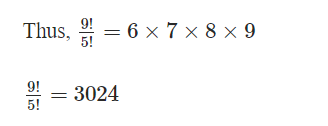Factorials
The factorial of a number has many and intensive uses in permutations, combinations and the computation of probability. We represent it by an exclamation mark (!). Factorials are also used in number theory, approximations, and statistics. In this topic, we will discuss the Factorial Formula with examples. We shall also learn the various applications of factorial formula such as permutations, combinations, probability distribution, etc.
In mathematics, symbols that have certain meanings in the English language can mean very specialized and different things. For example, consider the following expression:
3!
No, we did not use the exclamation point to show that we’re excited about three, and we shouldn’t read the last sentence with emphasis. In mathematics, the expression 3! is read as "three factorial" and is really a shorthand way to denote the multiplication of several consecutive whole numbers.
Since there are many places throughout mathematics and statistics where we need to multiply numbers together, the factorial is quite useful. Some of the main places where it shows up are combinatorics and probability calculus.
Definition
The definition of the factorial is that for any positive whole number n, the factorial:
n! = n x (n -1) x (n - 2) x . . . x 2 x 1
Examples for Small Values
First we will look at a few examples of the factorial with small values of n:
- 1! = 1
- 2! = 2 x 1 = 2
- 3! = 3 x 2 x 1 = 6
- 4! = 4 x 3 x 2 x 1 = 24
- 5! = 5 x 4 x 3 x 2 x 1 = 120
- 6! = 6 x 5 x 4 x 3 x 2 x 1 = 720
- 7! = 7 x 6 x 5 x 4 x 3 x 2 x 1 = 5040
- 8! = 8 x 7 x 6 x 5 x 4 x 3 x 2 x 1 = 40320
- 9! = 9 x 8 x 7 x 6 x 5 x 4 x 3 x 2 x 1 = 362880
- 10! = 10 x 9 x 8 x 7 x 6 x 5 x 4 x 3 x 2 x 1 = 3628800
As we can see the factorial gets very large very quickly. Something that may seem small, such as 20! actually has 19 digits.
Factorials are easy to compute, but they can be somewhat tedious to calculate. Fortunately, many calculators have a factorial key (look for the ! symbol). This function of the calculator will automate the multiplications.
A Special Case
One other value of the factorial and one for which the standard definition above does not hold is that of zero factorial. If we follow the formula, then we would not arrive at any value for 0!. There are no positive whole numbers less than 0. For several reasons, it is appropriate to define 0! = 1. The factorial for this value shows up particularly in the formulas for combinations and permutations.
More Advanced Calculations
When dealing with calculations, it is important to think before we press the factorial key on our calculator. To calculate an expression such as 100!/98! there are a couple of different ways of going about this.
One way is to use a calculator to find both 100! and 98!, then divide one by the other. Although this is a direct way to calculate, it has some difficulties associated with it. Some calculators cannot handle expressions as large as 100! = 9.33262154 x 10157. (The expression 10157 is a scientific notation that means that we multiply by 1 followed by 157 zeros.) Not only is this number massive, but it is also only an estimate to the real value of 100!
Another way to simplify an expression with factorials like the one seen here does not require a calculator at all. The way to approach this problem is to recognize that we can rewrite 100! not as 100 x 99 x 98 x 97 x . . . x 2 x 1, but instead as 100 x 99 x 98! The expression 100!/98! now becomes (100 x 99 x 98!)/98! = 100 x 99 = 9900.
Formula for the Factorial
To get the factorial of a given number n the following given formula can be used,
Also, the above computation can be done as follows:
For a number n, the factorial of it can be written as,
This is possible due to the recursive nature of factorial computation.
Let us understand it with some examples.
Some Applications of Factorial Value
Some applications of factorial in mathematics are as follows:
1)Recursion
In the recursive definition of a number, we may use factorial. A number can be expressed in an expression containing the number only.
2) Permutations
Arrangement of given r things out of total n things when order is strictly important.
3) Combinations
Arrangement of given r things out of total n things when order is not important.
4) Probability Distributions
There are various probability distributions like binomial distribution which include the use of factorial. To find the probability of an event, the concept of permutations and combinations is used a lot.
5) Number Theory
Factorials value are used extensively in number theory and also for approximations.
Solved Examples for Factorial Formula
Q.1: What is the value of 8!?
Solution: The formula for factorial is,
= 40320
Solution: The formula for factorial is,
Thus putting p =9
Similarly, Putting p = 5






No comments:
Post a Comment